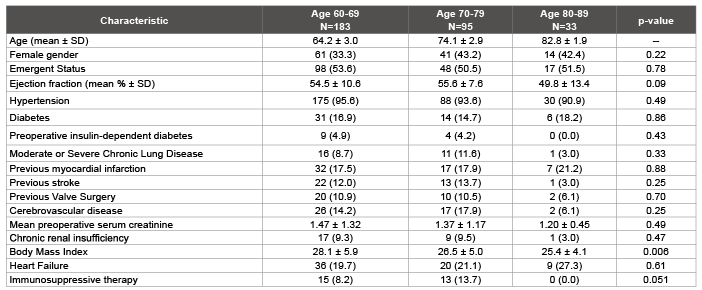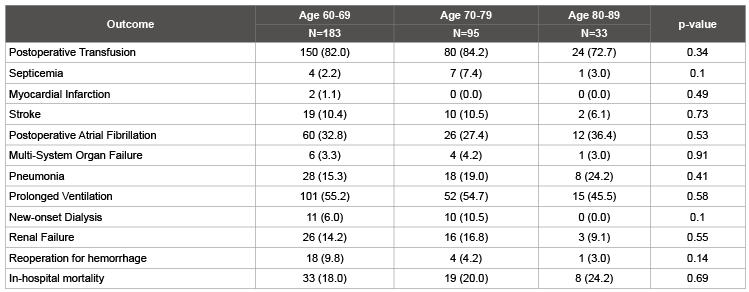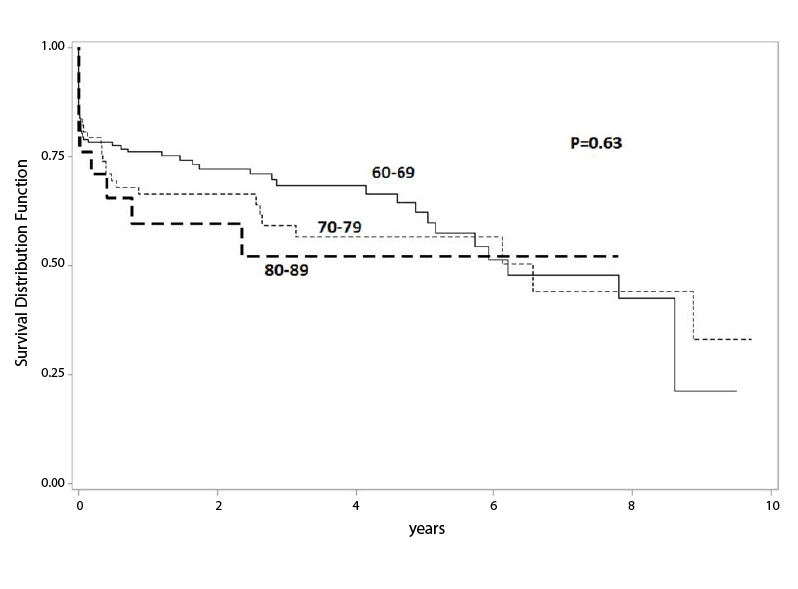
Table 1: Preoperative characteristics


W Brent Keeling*1 Bradley G Leshnower1 Edward P Chen1 Eric L Sarin1 Jose Binongo2 Omar M Lattouf1 Robert A Guyton1 Michael E Halkos1 Vinod H Thourani1
1Division of Cardiothoracic Surgery, Joseph B. Whitehead Department of Surgery, Emory University School of Medicine, Atlanta, Georgia, USA*Corresponding author: W Brent Keeling, 49 Jesse Hill Drive, Atlanta, GA 30303, Tel: (404) 561- 0539; Fax: (404) 616-4400; E-mail: brent.keeling@emory.edu
Introduction: Acute ascending aortic dissection (AAAD) is a potentially lethal disease that affects elderly patients with some frequency. The purpose of this study was to evaluate the short- and mid-term outcomes of elderly patients following surgery for AAAD.
Methods: A retrospective review of the local STS database of patients ≥ 60 years of age who underwent surgery for AAAD from 2003-2013 at a US academic center was performed (n=311). Patients were compared based on age groups: 60-69 years (n=183), 70-79 years (n=95) and 80-89 years (n=33). Additionally, chart review based on ICD-9 codes was undertaken to evaluate medically managed patients during the same timeframe. The Social Security Death Index was accessed for survival data. Unadjusted outcomes were compared, and mid-term survival was calculated using Kaplan-Meier curves.
Results: Octogenarians had comparable preoperative risk profiles compared to other elderly patients excepting lower body mass index (p=0.006) and underwent similar operations with no difference in concomitant coronary artery bypass grafting (p=0.19), cardiopulmonary bypass time (p=0.75), or aortic cross clamp time (p=0.71). In-hospital mortality rates by age group showed no statistical difference (p=0.69): 60-69 (18.0%), 70-79 (20.0%), and 80-89 (24.2%). There were no survivors in the group of octogenarians who underwent medical management only (0/2, p=0.07). Additionally, rates of postoperative stroke (p=0.73), renal failure (p=0.55), and myocardial infarction (p=0.49) were similar across age groups. Postoperative transfusion requirements were lower in octogenarians: 60-69 (82.0%), 70-79 (84.2%), 80-89 (72.7%) [p=0.34]. Mean 5-year survival was 62.3% for 60-69, 56.7% for 70-79, and 52.2% for 80-89. Mid-term survival was similar across all age groups (p=0.63).
Conclusion: Most octogenarians can safely undergo surgery for repair of AAAD with no difference in short-term outcomes compared to other elderly patients. Short-term survival for octogenarians compares favorably to previously published results, and mid-term survival is similar to other elderly patients.
Acute ascending aortic dissections (AAAD) represent potentially lifethreatening illnesses with a high rate of morbidity and mortality [1-4]. Historical mortality rates average 50 percent within the first 48 hours from onset. Mortality usually results from intra-pericardial aortic rupture or severe acute aortic valve regurgitation if left untreated. The preferred treatment option for eligible patients remains timely surgical intervention [4]. Even under optimal circumstances, data collected at multiple centers of excellence demonstrates an in-hospital mortality rate of 24% [2].
Some patients who present with AAAD are denied operative intervention based on multiple pre-existing comorbidities and undergo medical management. Best medical management strategies include negative chronotropes and strict blood pressure control [5]. As the general population ages, however, surgical intervention is increasingly being offered to older patients. In prior data from the IRAD (International Registry for Aortic Dissections) researchers, 51 octogenarians experienced an in-hospital mortality rate of 36% following surgical repair for AAAD [4]. This rate of survival was not significantly different from those octogenarians who underwent medical management (p=0.18). A group from Germany detailed the outcomes in octogenarians after surgery for AAAD from a multi-institutional database [6]. The mortality rate for this group of patients was 35%, but despite the high mortality rate, the authors recommended surgical intervention for AAAD independent of the age of the patient.
The purpose of this research was to investigate the treatment of type A aortic dissections in elderly patients. We hypothesized that few elderly patients underwent medical therapy alone for type A dissections and that outcomes were similar to other elderly patients.
A retrospective review of the local STS database of all patients ≥ 60 years of age who underwent surgery for AAAD from 2003-2013 at a US academic center was performed (n=311). All patients were included in this analysis. Patients were sorted by age: 60-69 years (n=183), 70-79 years (n=95), and 80-89 years (n=33). Additionally, manual chart review based on primary ICD-9 codes was undertaken to evaluate medically managed patients during the same timeframe (n=2). The Social Security Death Index was accessed for survival data when available. The local Institutional Review Board approved this study.
This study spans a long period of time with multiple surgeons involved but, nevertheless, some surgical techniques remained constant. Decisions regarding operative therapy (root replacement, perfusion strategy) were made exclusively by the attending surgeon. For patients all patients, standard cardiopulmonary bypass procedures were followed. Cold antegrade and/or retrograde cardioplegia were routinely utilized at the discretion of the attending surgeon. Typically, conventional cardiopulmonary bypass was performed utilizing roller head pumps, membrane oxygenators, cardiotomy suction, arterial filters, and systemic hypothermia. Current institutional practice includes unilateral selective antegrade cerebral perfusion general, moderate systemic hypothermia (28-30 degrees Centigrade), an open distal anastomosis followed by proximal work, and continuous cerebral oximetry monitoring throughout the duration of the case.
Data were gathered and compiled in a secure database. For quantitative variables, means and standard deviations are presented according to age group. Between group differences were tested using one-way analysis of variance. For categorical variables, counts and proportions are presented according to age group. Between group differences were tested using the chi-square test. Midterm survival was assessed, Kaplan-Meier curves created, and differences were tested using the log rank test. Multivariate regression analysis was omitted given the underlying similarities in preoperative comorbidities among age strata.
Of the 311 patients included in this study, 33 (10.6%) were octogenarians. Importantly, there was little difference in preoperative characteristics between the three groups of patients (Table 1). The octogenarians who underwent operative therapy for AAAD tended to have lower ejection fractions (p=0.09) but less utilization of preoperative immunosuppressive therapy (p=0.05). Not surprisingly, octogenarians had lower body mass indices than their elderly counterparts (p=0.006).

Table 1: Preoperative characteristics
Table 2 shows that octogenarians also underwent similar operations to the other two age cohorts. Aortic cross clamp and cardiopulmonary bypass times were similar across age groups (p=0.71 and 0.75, respectively). Additionally, octogenarians underwent concomitant CABG at similar rates to the other elderly patients (p=0.19).Octogenarians underwent similar rates of axillary cannulation and root replacement as compared to the other elderly patients.

Table 2: Operative data
Unadjusted postoperative outcomes as listed in Table 3 were similar across age groups. Of note, there was no statistically significant difference in in-hospital mortality (p=0.69). Additionally, transfusion requirements were similar in all age groups (p=0.34).

Table 3: Unadjusted Outcomes by Age Group
There were two octogenarians who presented with an acute type A dissection who were medically managed during the study period. Both patients died as a result of their aortic disease in the hospital. In-hospital survival for surgical versus medical therapy for AAAD approached statistical significance (p=0.07).
Mid-term-survival for octogenarians was encouraging (Table 4). 5-year survival was 52.2%, and this did not differ from survival rates of other elderly patients (p=0.63) (Figure 1).

Table 4: Mid-term survival

Figure 1: Survival by age group
Cooley and colleagues first reported on the surgical repair of aortic dissections in 1956, and since that time, the techniques utilized have continued to evolve [7]. As the safety of operative treatment of AAAD has improved, the range of patients offered therapy has greatly expanded. Recent advances in endovascular therapeutics and cerebral perfusion techniques have allowed for effective treatment of patients with preoperative mesenteric malperfusion as well as preoperative neurologic sequelae of type A dissections [8-10].
In addition to other preoperative comorbidities, advancing patient age continues to be a barrier to some surgeons in terms of operative therapy for AAAD. The IRAD database report on elderly patients published in 2010 failed to definitively conclude that surgical therapy was superior to medical therapy in octogenarians [4]. Additionally, that same manuscript documented a surgical mortality rate of 37.9% for patients aged 80-90. An Italian group demonstrated over 79 consecutive octogenarians a 44.3% in-hospital mortality following surgery for AAAD [11]. Despite the high rate of mortality, the authors concluded that most octogenarians with an uncomplicated type A dissection should undergo surgical repair.
Octogenarians in the current study had a similar preoperative comorbidity profile compared to the other elderly patients. One notable exception to this is the lower body mass index seen in octogenarians. Low body mass index has been linked to increased morbidity and mortality following cardiac surgery [12,13]. There is, however, no compelling data regarding body mass index in patients undergoing aortic surgery, and despite the lower body mass indices, octogenarians had similar postoperative outcomes to the other elderly patients.
Octogenarians who underwent medical therapy at our institution over the timeframe of the study were few, thus reflecting our institutional bias toward aggressive surgical management of virtually all patients with AAAD regardless of patient age. A thorough search was made for patients who were managed medically based on primary ICD-9 codes, and over the study period, only two were encountered. Both of these patients died during their subsequent hospitalizations. Octogenarians who underwent medical management of AAAD in the IRAD publication experienced a mortality rate of 55.2% [4]. The number of medically managed patients in this series is small, thus reflecting our institutional bias toward aggressive surgical management for virtually all patients with AAAD.
This study is not without limitations. Given the long period of the study and the many surgeons involved in the treatment of these patients, operative therapies differed, although many efforts have since been made at standardization. As this is a retrospective database driven study, it is subject to the inherent biases and problems in such an endeavor. While every effort was made to capture elderly patients with AAAD who were medically treated by looking at a variety of diagnosis related groups and individual patient charts, it is possible that some patients were not included.
In conclusion, this data adds to the growing body of work which demonstrates excellent perioperative outcomes in octogenarians who underwent surgical therapy for AAAD. Moreover, it provides data showing good mid-term survival in elderly patients as well, thus confirming our bias toward aggressive surgical management regardless of age.
Download Provisional PDF Here
Aritcle Type: Research Article
Citation: Keeling WB, Leshnower BG, Chen EP, Sarin EL, Binongo J, et al. (2016) Octogenarians Experience Outcomes Similar to Other Elderly Patients after Surgery for Acute Ascending Aortic Dissections. J Surg Open Access 2(1): doi http://dx.doi. org/10.16966/2470-0991.112
Copyright: © 2016 Keeling WB, et al. This is an open-access article distributed under the terms of the Creative Commons Attribution License, which permits unrestricted use, distribution, and reproduction in any medium, provided the original author and source are credited.
Publication history:
All Sci Forschen Journals are Open Access